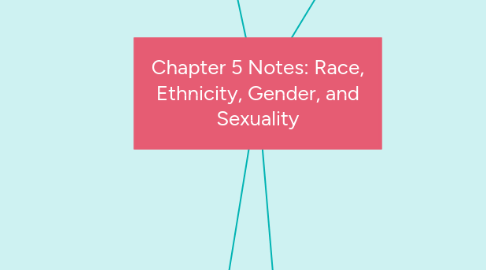
1. How do Places Affect Identity, And How do we See Identities In Places?
1.1. Intro
1.1.1. Sense of Place:
1.1.1.1. Connecting feelings and emotions to a place
1.1.1.2. Always fluid just like identity
1.1.1.3. Can become part of our identity
1.2. Ethnicity And Place
1.2.1. Ethnicity:
1.2.1.1. Greek for ethnos meaning people or nation
1.2.1.2. historically constucted
1.2.1.3. Part of identity
1.2.1.4. Changes across scales, places, and time
1.2.2. A conflict is often called ethnic when a racial distinction cannot easily be made
1.3. Identity and Space
1.3.1. Sexuality and Space
1.3.1.1. Queer Theory:
1.3.1.1.1. Highlights the nature of opposition to the heteronormative
1.3.1.1.2. Focuses on the political engagement of "queers" with the heteronormative
1.3.2. Space:
1.3.2.1. Social relations stretched out
1.3.3. Place:
1.3.3.1. Specific articulations of those social relations as they have come together, over time, in that particular location
2. How Does Geography Reflect and Shape Power Relationships Among Groups Of People?
2.1. Intro
2.1.1. Power has a direct and crucial factor to identity
2.2. Just Who Counts?
2.2.1. People create places that limit the access of other peoples without government help
2.2.2. Segregation is a big example
2.2.2.1. Even before the law in the U.S. said that blacks weren't equal to whites people treated blacks worse than whites
2.3. Vulnerable Populations
2.3.1. Disease creates vulnerable populations
2.3.2. Usually poorer or less supported
2.3.3. Usually children and women
2.4. Women In Sub-Saharan Africa
2.4.1. Women are usually left at home to tend to the farm and children and men go to the big cities so there aren't many men at all
2.5. Dowry Deaths In India
2.5.1. Happen when the bride's father fails to fill marriage agreement
2.5.2. Dowry:
2.5.2.1. The price paid by the bride's family to the groom's father
2.5.3. Thousands of girls die every year and the numbers keep going up
2.6. Shifting Power Relations among Ethnic Groups
2.6.1. America:
2.6.1.1. Whites dominant, create many restrictions for non-whites
2.6.1.2. Law is main power scorce
2.6.2. Power relations in Los Angeles
2.6.2.1. Many Hispanic-Latino people
2.6.2.2. Barronization:
2.6.2.2.1. The huge increase in Hispanic population
2.6.2.2.2. From 4%-90% in 40 years
3. Field Note
3.1. Brick-Making in the United States is way more developed than in Bali Indonesia
3.1.1. In Indonesia women and children make bricks for $.50 an hour and In the U.S. men and robots make the bricks
3.2. Gender
3.2.1. A culture's assumptions about the differences in men and women, what they represent
3.3. Many poorer countries choose women instead of men for labor because:
3.3.1. They are more easily exploited
3.3.2. They are less likely to go on strike or protest
3.3.3. They are better at assembly line tasks and are free of family responsibilities
4. What is Identity, And how Are Identities Structured?
4.1. Intro
4.1.1. Identity is marketed through:
4.1.1.1. Cars
4.1.1.2. Clothing
4.1.1.3. Club Memberships
4.1.1.4. Jewelry
4.1.1.5. Houses
4.1.2. Identity:
4.1.2.1. How we make sense of ourselves
4.1.2.2. Always changing
4.1.3. Identifying against other people is one of the most powerful ways to identify ourselves
4.2. Race
4.2.1. Race:
4.2.1.1. A categorization based on skin color, social status, etc.
4.2.2. Ideas about "Race" began in European colonization and exploration
4.2.2.1. They existed before, but they were mostly socioeconomic vs. mostly skin color
4.2.3. The racial distinctions today are drawn from categories in skin color that are from:
4.2.3.1. Cultural History
4.2.3.2. Power relationships
4.2.3.3. Politics of a place during the past years
4.2.4. People have created racial categories to justify:
4.2.4.1. Power
4.2.4.2. Economic Exploitation
4.2.4.3. Cultural Oppression
4.3. Race and Ethnicity in the United States
4.3.1. Race is usually assigned rather than chosen
4.3.2. Definitions of races have changed over time
4.3.3. The U.S. used to classify "Hispanic" as a race even though it involved both black and white people
4.3.3.1. Now it is more appropriately named an ethnicity
4.4. Residential Segregation
4.4.1. Residential segrigation:
4.4.1.1. The degree at which two or more groups live separately from each other, in different parts of cities
4.4.2. The U.S. census analyzed charted and mapped residential segregation by:
4.4.2.1. Evenness
4.4.2.2. Exposure
4.4.2.3. Concentration
4.4.2.4. Centralization
4.4.2.5. Clusters
4.4.3. In the U.S. residential segregation is declining
4.5. Identities Across Scales
4.5.1. We have different identities at different scales:
4.5.1.1. Regional
4.5.1.2. Global
4.5.1.3. Local
4.5.1.4. Individual
4.5.1.5. National
4.6. The Scale of New York City
4.6.1. Most of New York's "Hispanic" population is Puerto Rican or Dominican
4.6.2. Succession:
4.6.2.1. When new immigrant populations move into lower income neighborhoods that are being slowly abandoned by older immigrant populations
4.6.3. Most of New York's population growth has come from Mexicans
